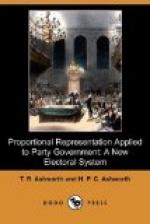But some reservation must be made. The Block Vote works best when the number of candidates does not exceed two or three times the number of vacancies. Suppose, first, that the candidates present in the final result a fairly regular order of favour from lowest to highest. Each of the successful candidates will then be supported by at least an absolute majority of the members, providing the number of candidates be not greater than twice the number of vacancies. But if there are four or five times as many candidates as vacancies, none of the successful candidates will have the support of a majority of the members. On the other hand, however, the candidates do not usually present a regular order of favour from lowest to highest when there are a large number of candidates, for there may be a long “tail” of candidates who receive very few votes. The following general rule may therefore be laid down:—The Block Vote works best when the total votes given to rejected candidates do not exceed the total votes given to successful candidates.
The difficulties indicated above were met by the Australian Natives’ Association by a plan which provided that no candidate should be elected except by an absolute majority of the voters. The Block Vote is used throughout; and if at the first ballot the required number of candidates do not obtain an absolute majority a second ballot is held, from which those at the bottom of the poll and those who have been elected are eliminated. This process is continued till all the vacancies are filled. Four or five ballots are sometimes required, and the proceedings become very irksome. A sub-committee was recently appointed to investigate the subject, and reported in favour of the Preferential System with one count only. The process of elimination was considered too complicated to be practicable. Now, the conditions presented by these elections, in which a very large number of candidates are generally nominated, are precisely those in which Preferential Voting lends itself most easily to abuse. An insignificant minority may defeat a candidate who should be elected, by placing him at the bottom of their lists.
A variation of the Block Vote may be suggested which is much simpler and better. The preferential ballot papers should be used, and two counts should be made. At the first count the primary half of the preferences should be counted as effective votes, and the candidates should be reduced to twice the number of vacancies. A second count should then be made of the ballot papers, using the Block Vote. All or nearly all the candidates would then obtain an absolute majority, and it is practically impossible that any candidate should be eliminated by the first count who would have had any chance of election in the second.
This plan is far superior to the original method. It is right that members who vote for candidates who are hopelessly out of it should be allowed to transfer their votes; but it is not right that members who first help to elect some candidates at one ballot should have the same voting power as others at subsequent ballots.




